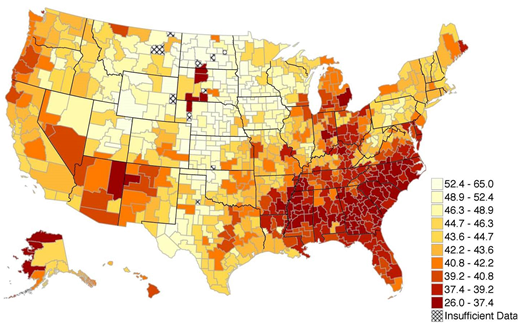The US is often hailed as the land of opportunity, a society in which a child's chances of success depend little on her family background. Is this reputation warranted? An extensive empirical literature on intergenerational mobility, reviewed by Solon (1999), Grawe and Mulligan (2002), and Black and Devereux (2011), has compared mobility across countries and have found that relative mobility is lower in the US than in other developed countries. In new research (Chetty et al. 2014) we show that this question does not have a clear answer because there is substantial variation in intergenerational mobility across areas within the US. The US is better described as a collection of societies, some of which are `lands of opportunity’ with high rates of mobility across generations, and others in which few children escape poverty.
New evidence on intergenerational mobility
We present a new portrait of social mobility in the US by compiling statistics from millions of anonymous earnings records. Our core sample consists of all children in the US born between 1980-82, whose income we measure in 2011-12, when they are approximately 30 years old.
Using these income data, we calculate two measures of intergenerational mobility. The first, relative mobility, measures the difference in the expected economic outcomes between children from high-income and low-income families. The second, absolute upward mobility, measures the expected economic outcomes of children born to a family earning an income of approximately $30,000 (the 25th percentile of the income distribution).
We construct measures of relative and absolute mobility for 741 “commuting zones” in the US. Commuting zones are geographical aggregations of counties that are similar to metro areas but also cover rural areas. Children are assigned to a zone based on their location at age 16 (no matter where they live as adults), so that their location represents where they grew up. When analysing local area variation, we rank both children and parents based on their positions in the national income distribution. Hence, our statistics measure how well children do relative to those in the nation as a whole rather than those in their own particular community.
We find substantial variation in mobility across areas (Figure 1). To take one example, children from families at the 25th percentile in Seattle have outcomes comparable to children from families at the median in Atlanta. Some cities – such as Salt Lake City and San Jose – have rates of mobility comparable to countries with the highest rates of relative mobility, such as Denmark. Other cities – such as Atlanta and Milwaukee – have lower rates of mobility than any developed country for which data are currently available.
Figure 1. Intergenerational mobility in the US
Notes: This map shows the average percentile rank of children who grow up in below-median income families across areas of the US (absolute upward mobility). Lighter colours represent areas where children from low-income families are more likely to move up in the income distribution. To look up statistics for your own city, use the interactive version of this map created by The New York Times.
What drives social mobility?
Next, we analyse what drives the variation in social mobility across areas. The spatial patterns of the gradients of college attendance and teenage birth rates with respect to parent income across zones are very similar to the pattern in intergenerational income mobility. The fact that much of the spatial variation in children's outcomes emerges before they enter the labour market suggests that the differences in mobility are driven by factors that affect children while they are growing up.
We explore such factors by correlating the spatial variation in mobility with observable characteristics. We begin by showing that upward income mobility is significantly lower in areas with larger African-American populations. However, white individuals in areas with large African-American populations also have lower rates of upward mobility, implying that racial shares matter at the community (rather than individual) level. One mechanism for such a community-level effect of race is segregation. Areas with larger black populations tend to be more segregated by income and race, which could affect both white and black low-income individuals adversely. Indeed, we find a strong negative correlation between standard measures of racial and income segregation and upward mobility. Moreover, we also find that upward mobility is higher in cities with less sprawl, as measured by commute times to work. These findings lead us to identify segregation as the first of five major factors that are strongly correlated with mobility.
The second factor we explore is inequality. Commuting zones with larger Gini coefficients have less upward mobility, consistent with the “Great Gatsby curve” documented across countries (Krueger 2012, Corak 2013). In contrast, top 1% income shares are not highly correlated with intergenerational mobility both across zones within the US and across countries. Although one cannot draw definitive conclusions from such correlations, they suggest that the factors that erode the middle class hamper intergenerational mobility more than the factors that lead to income growth in the upper tail.
Third, proxies for the quality of the K-12 school system are also correlated with mobility. Areas with higher test scores (controlling for income levels), lower dropout rates, and smaller class sizes have higher rates of upward mobility. In addition, areas with higher local tax rates, which are predominantly used to finance public schools, have higher rates of mobility.
Fourth, social capital indices (Putnam 1995) – which are proxies for the strength of social networks and community involvement in an area -- are very strongly correlated with mobility. For instance, high upward mobility areas tend to have higher fractions of religious individuals and greater participation in local civic organisations.
Finally, the strongest predictors of upward mobility are measures of family structure such as the fraction of single parents in the area. As with race, parents' marital status does not matter purely through its effects at the individual level. Children of married parents also have higher rates of upward mobility if they live in communities with fewer single parents.
We find modest correlations between upward mobility and local tax and government expenditure policies and no systematic correlation between mobility and local labour market conditions, rates of migration, or access to higher education.
Caveats
We caution that all of the findings in this study are correlational and cannot be interpreted as causal effects. For instance, areas with high rates of segregation may also have other characteristics that could be the root cause driving the differences in children’s outcomes.
What is clear from this research is that there is substantial variation in the US in the prospects for escaping poverty. Understanding the properties of the highest mobility areas – and how we can improve mobility in areas that currently have lower rates of mobility – is an important question for future research that we and other social scientists are exploring.
To facilitate this ongoing work, we have posted the mobility statistics by area and the other correlates used in the study on the project website.
References
Black, Sandra E. and Paul J. Devereux (2011), "Recent Developments in Intergenerational Mobility" in O Ashenfelter and D Card (eds.), Handbook of Labor Economics, Vol. 4, Elsevier, chapter 16, pp. 1487-1541.
Chetty, Raj, Nathaniel Hendren, Patrick Kline, and Emmanuel Saez (2014), “Where is the Land of Opportunity? The Geography of Intergenerational Mobility in the US”, NBER Working Paper 19843
Corak, Miles (2013), Income Inequality, Equality of Opportunity, and Intergenerational Mobility." Journal of Economic Perspectives, 27 (3): 79-102.
Grawe, Nathan D and Casey B Mulligan (2002), Economic Interpretations of Intergenerational Correlations", Journal of Economic Perspectives, 16 (3): 45-58.
Krueger, Alan (2012), "The Rise and Consequences of Inequality in the US", Speech at the Center for American Progress, Washington D.C. on 12 January.
Solon, Gary (1999), "Intergenerational Mobility in the Labor Market" in O Ashenfelter and D Card, (eds.), Handbook of Labor Economics, Vol. 3, Elsevier, pp. 1761-1800.







